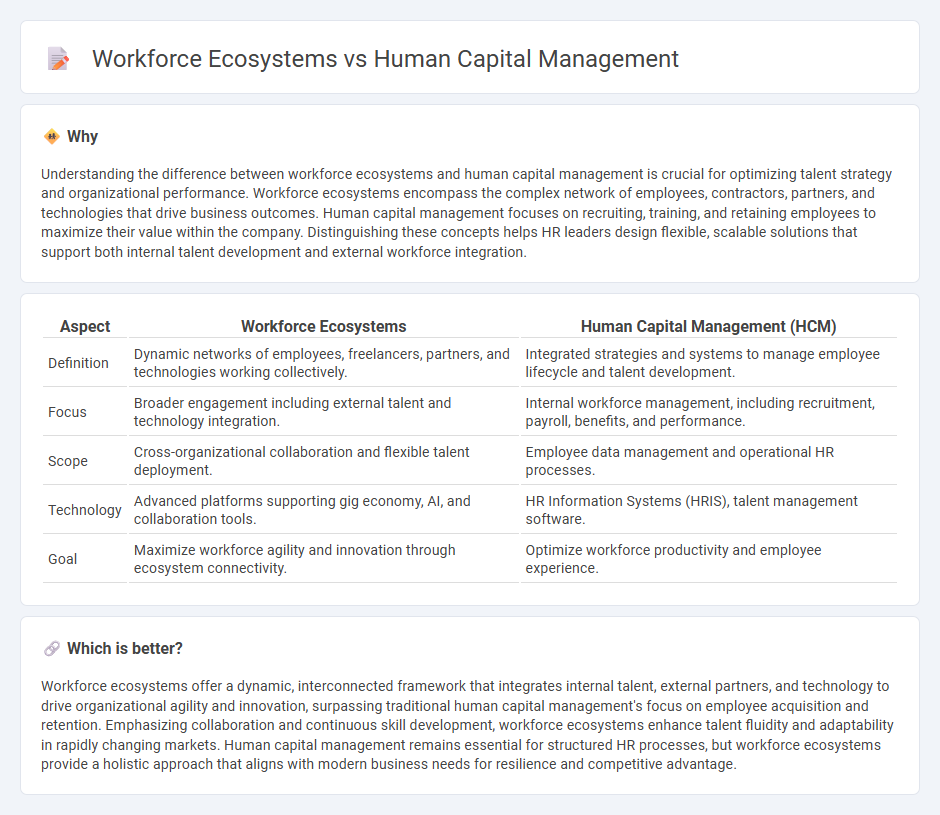
Workforce ecosystems encompass the entire network of internal employees, external contractors, partners, and technologies driving organizational performance. Human capital management focuses on optimizing employee recruitment, development, and retention through strategic processes and data analytics. Explore how integrating workforce ecosystems with human capital management transforms talent strategies and operational success.
Why it is important
Understanding the difference between workforce ecosystems and human capital management is crucial for optimizing talent strategy and organizational performance. Workforce ecosystems encompass the complex network of employees, contractors, partners, and technologies that drive business outcomes. Human capital management focuses on recruiting, training, and retaining employees to maximize their value within the company. Distinguishing these concepts helps HR leaders design flexible, scalable solutions that support both internal talent development and external workforce integration.
Comparison Table
| Aspect | Workforce Ecosystems | Human Capital Management (HCM) |
|---|---|---|
| Definition | Dynamic networks of employees, freelancers, partners, and technologies working collectively. | Integrated strategies and systems to manage employee lifecycle and talent development. |
| Focus | Broader engagement including external talent and technology integration. | Internal workforce management, including recruitment, payroll, benefits, and performance. |
| Scope | Cross-organizational collaboration and flexible talent deployment. | Employee data management and operational HR processes. |
| Technology | Advanced platforms supporting gig economy, AI, and collaboration tools. | HR Information Systems (HRIS), talent management software. |
| Goal | Maximize workforce agility and innovation through ecosystem connectivity. | Optimize workforce productivity and employee experience. |
Which is better?
Workforce ecosystems offer a dynamic, interconnected framework that integrates internal talent, external partners, and technology to drive organizational agility and innovation, surpassing traditional human capital management's focus on employee acquisition and retention. Emphasizing collaboration and continuous skill development, workforce ecosystems enhance talent fluidity and adaptability in rapidly changing markets. Human capital management remains essential for structured HR processes, but workforce ecosystems provide a holistic approach that aligns with modern business needs for resilience and competitive advantage.
Connection
Workforce ecosystems integrate diverse talent sources, technologies, and organizational structures to enhance human capital management (HCM) by enabling dynamic talent acquisition, development, and retention strategies. Human capital management leverages data-driven insights from workforce ecosystems to optimize employee performance, engagement, and succession planning. This connection fosters agility and innovation, ensuring organizations adapt to evolving market demands and maximize workforce potential.
Key Terms
**Human Capital Management:**
Human Capital Management (HCM) focuses on recruiting, developing, and retaining employees to maximize organizational performance through strategic workforce planning, talent acquisition, and performance management. It integrates technology solutions such as HCM software platforms to streamline payroll, benefits administration, and employee engagement. Explore how advanced HCM strategies can transform your organization's talent lifecycle and drive competitive advantage.
Talent Acquisition
Talent Acquisition in human capital management centers on recruiting and retaining skilled employees through structured processes and strategic workforce planning. Workforce ecosystems expand this focus by integrating external partners, technology platforms, and gig workers to create a dynamic talent network. Explore how these approaches transform talent acquisition strategies to stay competitive in evolving labor markets.
Performance Management
Human capital management (HCM) centers on optimizing employee performance through structured evaluation, goal setting, and development programs, ensuring alignment with organizational objectives. Workforce ecosystems expand this focus by integrating external partners, gig workers, and technology platforms to enhance performance management across a broader talent network. Explore how evolving performance management strategies within workforce ecosystems drive agility and innovation.
Source and External Links
Human Capital Management (HCM) - BambooHR - Human Capital Management is a strategic corporate approach to recruit, manage, and develop an organization's workforce to maximize individual value, including practices such as workforce planning, recruiting, training, performance management, and benefits administration for enhancing employee productivity and company success.
What Is Human Capital Management: A Comprehensive Guide - HCM encompasses organizational practices for acquiring, managing, and developing human capital with the goal of optimizing the economic value of employees and gaining a competitive advantage through talent acquisition, training, performance management, workforce analytics, and employee retention.
What is Human Capital Management? | Practices & Software - ADP - Human Capital Management is the process of hiring the right people, managing workforces effectively, and optimizing productivity via integrated administrative and strategic functions like recruitment, payroll, talent management, compliance, and data analytics to improve workforce productivity and support business strategy.
 dowidth.com
dowidth.com